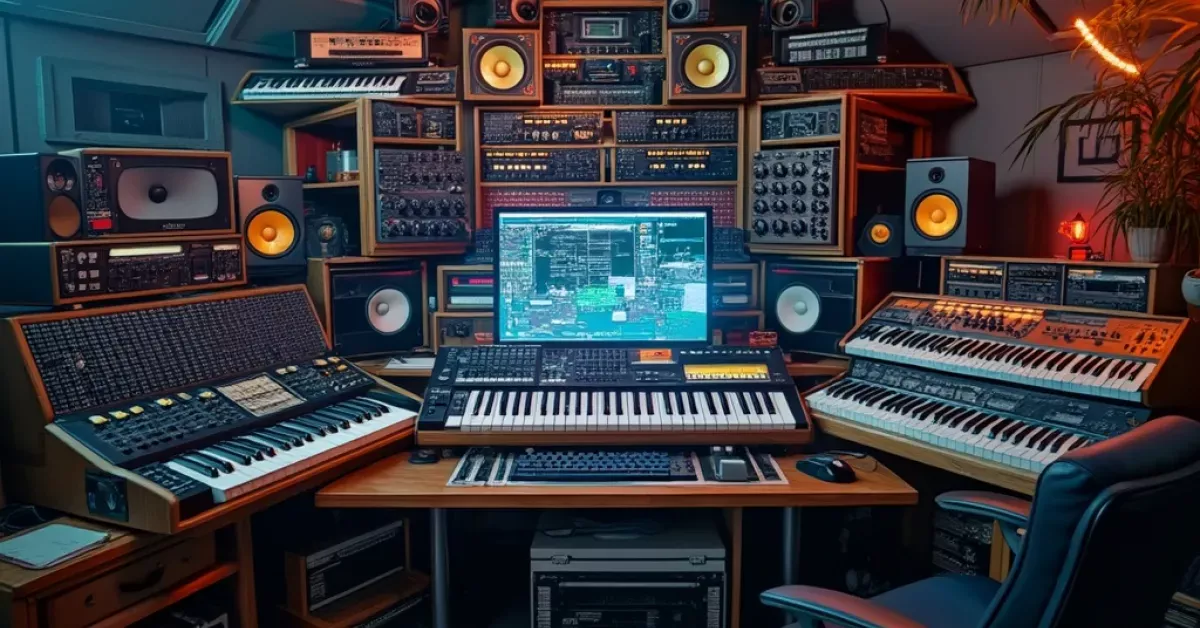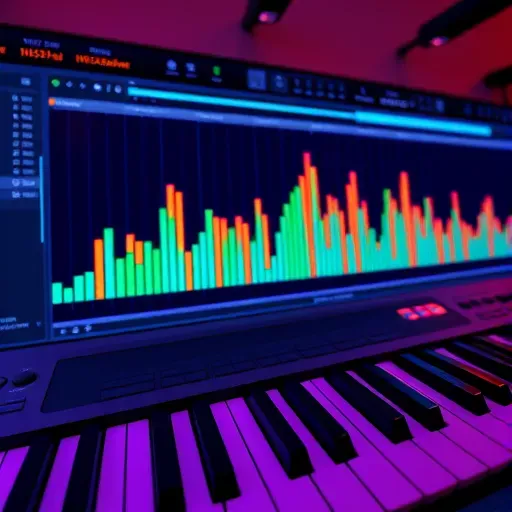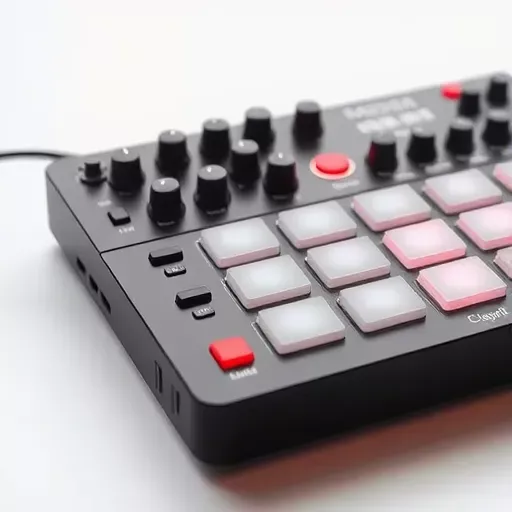MIDI might sound like just another tech acronym, but this powerful protocol is the unsung hero that’s orchestrated the music revolution. Whether you’re doing a deep dive into music production or tinkering with your first beat, understanding MIDI—Musical Instrument Digital Interface—will give you a backstage pass to the magic of modern sound creation.

The Birth of MIDI: Unveiling the Revolutionary Music Protocol
Back in the early 1980s, a group of innovative music minds sought a universal language that could let different electronic instruments talk to each other. MIDI was born, a revolutionary protocol that changed everything about how music was made. Imagine trying to play a symphony with musicians who didn’t speak the same language—chaos, right? MIDI solved that by making sure every instrument, from synthesisers to computers, could speak in unison.
How MIDI Transformed Music Production
MIDI opened doors to endless creative possibilities. By acting as a bridge between instruments, it allowed musicians to control one instrument from another. Think of a drummer who can make a keyboard sing or a guitarist who can tap into the vast sound libraries of a computer. This kind of control was once a dream, but MIDI turned it into a widespread reality, impacting genres from pop to film scores.
The Historical Significance of MIDI
Historically, MIDI is like the Rosetta Stone of the electronic music world. Before it, communicating across devices was cumbersome and clunky. With MIDI, musicians could explore electronic music without getting bogged down by tech troubles. It was this backbone that supported the rise of new sounds and genres, making it a pivotal point in music evolution.
MIDI’s Role in Shaping Modern Music
Today, MIDI is as crucial as the strings on a guitar. From syncing a whole live performance to tweaking sound levels in a tiny home studio, MIDI’s role is monumental. It fuelled the digital music explosion, enabling artists to delve into vast soundscapes and innovate beyond traditional barriers.
MIDI Protocol: Bridging Digital Instruments and Creativity
Understanding the MIDI Protocol
The MIDI protocol is essentially a gentle puppet master behind the curtain. It sends messages, not sounds themselves, instructing devices on how to play their notes, chords, or even entire orchestral symphonies. This lets musicians experiment without physically altering instruments, giving rise to a creative playground where the sky’s the limit!
Enhancing Workflow with MIDI
Picture this: crafting a hit melody without leaving your seat. MIDI streamlines the creative process, letting musicians tweak compositions on the fly. From looping a catchy drum beat to altering tempo and dynamics, MIDI ensures artists can focus more on creativity and less on troubleshooting technicalities.
Boosting Creativity in Music Production
With MIDI, the canvas is infinite. Musicians can layer sounds, experiment with textures, and play around with musical ideas with unprecedented ease. Creativity soars as producers paint with sounds, utilising MIDI to breathe life into digital instruments.
🎥 Create Publish-Worthy Videos on Day One with InVideo!
Simplify video creation with InVideo's ready-made templates. Customize with ease, even if you're new to video editing. Boost your brand with stunning, professional-quality videos in minutes!
- ✔️ Over 5,000 professionally designed templates
- ✔️ AI tools for script generation & text-to-video editing
- ✔️ 8M+ stock media assets included
- ✔️ No credit card required to start
From Sound Files to Masterpieces: MIDI in Electronic Music
Precision in Sound Design with MIDI
In electronic music, precision is everything. MIDI allows for intricate control over each musical element, serving as an artist’s paintbrush to design complex sounds and rhythms. This accuracy makes it possible to craft incredible beats and harmonies that define modern EDM and electronic compositions.
Creating Innovative Soundscapes
MIDI is the architect behind many iconic soundscapes. Artists embrace it for its flexibility in crafting sounds that can narrate emotional stories or conjure futuristic worlds. MIDI’s adaptability has sculpted many legendary tracks, etching its importance in the annals of music innovation.
The Art of Sonic Manipulation
One of MIDI’s most potent aspects is its ability to manipulate sound. Musicians can take a basic tune and twist it into a completely new entity. This sonic sculpting allows for playful experimentation, pushing the boundaries of what music can be, often leading to surprising and delightful musical results.

Exploring the pivotal role of MIDI in crafting electronic soundscapes.
DAW Integration: Elevating Music Composition with MIDI
Bringing MIDI into Your DAW
Integrating MIDI into digital audio workstations (DAWs) has revolutionised music composition. It’s like having a full orchestra at your fingertips, ready to play whatever you command. DAWs with MIDI can transform how musicians compose, allowing easy navigation through an ocean of virtual instruments and effects.
Streamlining Music Production Processes
Using MIDI with a DAW can be a game changer. It simplifies the creation process, enabling artists to layer sounds effortlessly, edit audio tracks, and arrange vast compositions with the click of a button. It turns a simple tune into a professional masterpiece, facilitating smoother workflows and reducing production time.
MIDI’s Impact on Arranging and Editing
MIDI offers incredible control during the arranging and editing stages of music production. Artists can swiftly adjust tempos, transpose notes, or rearrange entire sections, all while maintaining the integrity of the original piece. This flexibility allows for precise musical editing, ensuring the final track is polished and pristine.
MIDI Controllers: The Heartbeat of Modern Music Production
Benefits of Using MIDI Controllers
MIDI controllers are like the steering wheels of the music world. They let artists interact with computers in the most tactile way, transforming abstract sounds into concrete expressions. Some benefits include flexible mapping to actions, creating dynamic performance experiences, or even just the sheer delight of physical interaction devoid of a mouse and keyboard.
Interacting with Synthesizers and Virtual Instruments
For many artists, MIDI controllers make playing synthesisers and virtual instruments feel more authentic. They provide a hands-on approach which translates into more emotional, human-like performances. This interaction is crucial in bridging the gap between technology and traditional musicality.
Intuitive Interfaces for Music Creativity
MIDI controllers offer a user-friendly gateway into music production. With knobs, sliders, and pads at your disposal, those daunting digital landscapes turn into a playground. It’s an intuitive approach that boosts creativity, allowing musicians to explore ideas without restrictive barriers.

A MIDI controller exemplifying the connection between technology and musical creativity.
The Role of MIDI in Pioneering Music Innovation
Connecting Music Technology with Tradition
MIDI is a brilliant connector, harmoniously blending the old and the new. It ensures that traditional sounds don’t get lost in the tech shuffle, allowing artists to incorporate classical instruments into digital projects seamlessly. This compatibility keeps music rich and versatile.
MIDI’s Influence on Music Evolution
Over the decades, MIDI has seamlessly shaped how music evolves. Its flexibility inspires musicians to mix genres, try new techniques, and break old rules, thus driving forward the musical evolution while staying true to its roots.
Driving Innovation in Sound Design
MIDI’s adaptability in sound design is unmatched, inspiring innovation in composition and performance. It stimulates fresh ideas by allowing dynamic control over music elements, encouraging talents to push boundaries and explore uncharted sonic territories.
Unlocking Digital Audio Potential with MIDI
MIDI in Professional Studio Setups
Professional studios rely heavily on MIDI to sync multiple elements with precision. It empowers producers to maintain consistency across various sessions, ensuring every release is smooth and harmonious. MIDI is a silent partner in some of the most advanced studio setups around the globe.
Enhancing Home Studio Capabilities
For home studios, MIDI is a true powerhouse. It offers users the ability to create pro-level tracks without the prohibitive costs of big equipment. This accessibility empowers indie artists to create music that stands toe to toe with major studio productions.
MIDI’s Function in Digital Audio Environments
Digital audio environments thrive on MIDI. It underpins everything from sound synchronization in video games to cutting-edge virtual reality experiences. MIDI helps make music inclusive, democratic, and above all, transformative, regardless of the setting.
Practical MIDI Applications: Sound Design and Composition
Synthesizing Unique Sounds with MIDI
MIDI is the ultimate enabler when it comes to synthesizing one-of-a-kind sounds. Musicians can explore vast virtual instrument libraries and modify sounds in endless ways, crafting unique auditory experiences that capture audiences worldwide.
MIDI’s Place in Music Theory
MIDI tools align beautifully with music theory, making exploration and teaching more interactive. They assist both beginners and veterans in understanding traditional music concepts while offering real-time playback that aids in learning and creation.
Exploring MIDI in Contemporary Music Creation
MIDI is at the forefront of modern music creation. Artists harness its capabilities to blend various styles, ensuring each track is fresh, engaging, and rhythmically diverse. It’s the linchpin that keeps contemporary music vibrant and ever-evolving.
So there you have it! From its incredible journey since the early ’80s to its modern-day magic, MIDI has been the unsung hero behind many melodies, rhythms, and innovations. Whether you’re composing your first track or building a digital symphony, understanding and utilising MIDI can open up a world of new possibilities. Get out there and let MIDI take your music to new heights!
